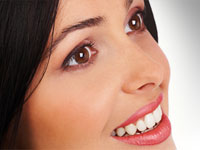Your Dental Makeover: Discover How Plastic Surgery Relates To Cosmetic Dentistry

Cosmetic dentistry and plastic surgery both blend health care with artistry and beautification. However, before we can beautify a person's smile, we must have a complete understanding of your dental makeover, not just an appreciation of, beauty.
Some of the first people to understand beauty were not health care specialists, but rather, artists. Great painters and sculptors studied anatomy, perspective, illusion, proportion, idealism and symmetry in order to recreate the beauty they saw.
Esthetic surgeons and cosmetic dentists create better-looking smiles. A cosmetic dentist creates pleasing-looking teeth, while the surgeon helps you feel more like smiling.
If cosmetic dentists and esthetic surgeons want to create beautiful smiles, they must begin to think like the great dental makeover artists. Michelangelo would never have considered one of his masterpieces complete until it was framed properly. The same goes for cosmetic dentistry. If we think of the teeth as the masterpiece, the frame is the surrounding soft tissue (such as the gums, jawbones, facial muscles, lips, and skin). We cannot consider one without the other.
Let's look at the areas of the face that contribute to the smile.
The Lips Form the Smile
The support of the lips is very important. If the teeth are properly contoured and there is a normal bite, the lip support is nearly always adequate. When it is inadequate, it is correctable.
Aside from the teeth, the chin also plays a role in the shape of the lips. A weak chin can give lips a protruded appearance. The solution is to increase the fullness of the chin through cosmetic plastic surgery.
The Mouth Is the Center of the Smile
The next area of cosmetic dentistry focus in your dental makeover is the shape of the mouth. The lips and the teeth are of primary importance to the support of the lips; however, the facial muscles of expression are what control the smile.
When the corners of the mouth are either turned up or down, they convey the feeling of happiness or sadness. Soft tissue corrections around the mouth should be corrected after the teeth and jawbones are corrected.
Other facial features that can be surgically altered to contribute to a terrific smile are:
- The nose may shadow the smile; The nose helps to proportion the smile in how it relates to the mouth and cheeks.
- The chin aids in determining facial balance; A prominent or deficient chin can affect facial symmetry.
- The jaws help shape the face and smile; A deficient upper or lower jaw can divert attention away from the smile and lay focus on the deficiency.
- The cheeks lift the corner of the smile; Sagging facial tissue that hides nicely-shaped lips, cheeks, and jawbones can be "lifted" to once again feature a pleasing smile.
- The brows and lids usually contribute greatly to the smile; thick upper eyelids that make people look tired or sad can be thinned.
- The skin may be wrinkled by smiling or frowning; Small facial muscles placing tension on the skin sometimes cause fine aging lines. They can be corrected through chemical peels, Botox injections, dermabrasion or a combination of these along with a facelift.
For further information on your dental makeover, consult with a cosmetic dentist, dermatologist or plastic surgeon. Each of these specialists works in close relationship with each other and can further counsel you on the best cosmetic dentistry treatment to improve your smile.
By Benjamin O. Watkins, III, DDS

+Jim Du Molin is a leading Internet search expert helping individuals and families connect with the right dentist in their area. Visit his author page.
Can Restorative Dentistry Treat the Dark Spaces Between My Teeth and Gums?

The appearance of your teeth is heavily impacted by the position of the surrounding gum tissue. In a normal situation, two teeth that are side by side in your mouth have contact with each other. Below this contact, the area is filled in with gum tissue in the shape of a triangle. This triangular-shaped gum tissue is called the papilla. It is not uncommon to have an empty space in the area where the papilla is supposed to be. If this occurs, the result is perceived as a black space.
What Causes the Black Spaces in My Gums and How Can Restorative Dentistry Help?
They are caused by a loss of the gum tissue itself or by the shape and/or position of the teeth. For any black space that is present, the first thing that needs to be done is to diagnose what caused it to occur. Once this is done, the restorative dentistry treatment choice can be made. The best decision will be the most conservative treatment that corrects the black space.
One of the most common causes of loss of gum tissue is due to the gum disease known as periodontitis. This gum disease acts on the supporting bone around the teeth, causing a loss of bone. This loss of bony support causes the papilla to slump and flatten, creating a black space between the teeth. The first step in treating the resulting black space in this situation is to treat the cause. Once the gum disease is under control, the black spaces can then be addressed with restorative dentistry.
To remove the black spaces, the teeth need to have restorations placed that will change the shape of the teeth and fill in this space. The type of restorative dentistry can vary depending on whether or not there are any other problems with the teeth. The simplest and most conservative restoration is composite, a tooth-colored filling material. It can be bonded directly on the tooth in the area of the black space. Since it is placed only in the affected area, the situation where this is used requires that the overall appearance of the tooth is acceptable and does not need to be changed.
If the overall appearance of the tooth needs to be altered, then a different type of restorative dentistry needs to be used. The choice is either a dental veneer or a dental crown. The choice between the two depends on both the appearance and the structural changes that need to be done. Usually, to correct a black space, both teeth on either side need to be restored. In doing this, the symmetry between the teeth will remain the same. If you restored just one tooth, you would end up with one tooth being wider than the other. The advantage of using restorative dentistry to correct black spaces is that it usually results in a shorter treatment time.
Another cause of the black space is due to the position of the teeth themselves. One example is teeth that are tilted towards each other. When this occurs, the area for your gum tissue to fill becomes too large for the amount of tissue you have. This same concept may occur with certain types of tooth shapes. In these instances, the restorative dentistry treatment of choice is to use orthodontics (braces) to align the teeth. The advantage of doing this is that the black space will disappear without having to do any restorations on the teeth.
By Greggory Kinzer, DDS, MSD

+Jim Du Molin is a leading Internet search expert helping individuals and families connect with the right dentist in their area. Visit his author page.






